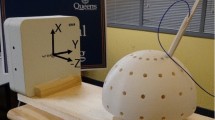Abstract
Purpose
An electromagnetic (EM) surgical tracking system was developed for orthopedic navigation. The reportedly poor accuracy of point-based EM navigation was improved by using anatomical impressions, which were EM-tracked personalized templates. Lines, rather than points, were consistently used for calibration and error evaluation.
Methods
Technical accuracy was tested using models derived from CT scans of ten cadaver shoulders. Tracked impressions were first designed, calibrated, and tested using lines as fiducial objects. Next, tracked impressions were tested against EM point-based navigation and optical point-based navigation, in environments that were either relatively empty or that included surgical instruments. Finally, a tracked impression was tested on a cadaver forearm in a simulated fracture-repair task.
Results
Calibration of anatomical impressions to EM tracking was highly accurate, with mean fiducial localization errors in positions of 0.3 mm and in angles of \(0.6^\circ \). Technical accuracy on physical shoulder models was also highly accurate; in an EM field with surgical instruments, the mean of target registration errors in positions was 2.2 mm and in angles was \(3.7^\circ \). Preclinical accuracy in a cadaver forearm in positions was 0.4 mm and in angles was \(7.1^\circ \). The technical accuracy was significantly better than point-based navigation, whether by EM tracking or by optical tracking. The preclinical accuracy was comparable to that achieved by point-based optical navigation.
Conclusions
EM-tracked impressions—a hybrid of personalized templates and EM navigation—are a promising technology for orthopedic applications. The two technical contributions are the novel hybrid navigation and the consistent use of lines as fiducial objects, replacing traditional point-based computations. The accuracy improvement was attributed to the combination of physical surfaces and line directions in the processes of calibration and registration. The technical studies and preclinical trial suggest that EM-tracked impressions are an accurate, ergonomic innovation in image-guided orthopedic surgery.





Similar content being viewed by others
References
Amaral GJA, Dryden IL, Wood ATA (2007) Pivotal bootstrap methods for k-sample problems in directional statistics and shape analysis. J Am Stat Assoc 102(478):695–707
Arun KS, Huang TS, Blostein SD (1987) Least-squares fitting of two 3-d point sets. IEEE Trans Pattern Anal Mach Intell 9(5):698–700
Hummel JB, Bax MR, Figl ML, Kang Y, Maurer C Jr, Birkfellner W, Bergmann H, Shahidi R (2005) Design and application of an assessment protocol for electromagnetic tracking systems. Med Phys 32(7):2371–2379
Koivukangas T, Katisko JPA, Koivukangas JP (2013) Technical accuracy of optical and the electromagnetic tracking systems. Springerplus 2(1):90
Kunz M, Balaketheeswaran S, Ellis RE, Rudan JF (2015) The influence of osteophytes depiction in CT for patient-specific guided hip resurfacing procedures. Int J Comput Assist Radiol Surg 10(6):717–726
Kunz M, Xenoyannis GL, Rudan JF, Ellis RE (2010) Computer-assisted hip resurfacing using individualized drill templates. J Arthroplasty 25(4):600–606
Li JM, Bardana DD, Stewart AJ (2011) Augmented virtuality for arthroscopic knee surgery. Med Image Comput Comput Assist Interv LNCS 6891:186–193
Lugez E, Sadjadi H, Pichora DR, Ellis RE, Akl SG, Fichtinger G (2015) Electromagnetic tracking in surgical and interventional environments: usability study. Int J Comput Assist Radiol Surg 10(3):253–262
Ma B, Ellis RE (2003) Robust registration for computer-integrated orthopedic surgery: laboratory validation and clinical experience. Med Image Anal 7(3):237–250
Nijkamp J, Schermers B, Schmitz S, de Jonge S, Kuhlmann K, van der Heijden F, Sonke JJ, Ruers T (2016) Comparing position and orientation accuracy of different electromagnetic sensors for tracking during interventions. Int J Comput Assist Radiol Surg 11(1):1–12. doi:10.1007/s11548-015-1348-1
Seeberger R, Kane G, Hoffmann J, Eggers G (2012) Accuracy assessment for navigated maxillo-facial surgery using an electromagnetic tracking device. J Craniomaxillofac Surg 40(2):156–161. doi:10.1016/j.jcms.2011.03.003
Stevens F, Conditt MA, Kulkarni N, Ismaily SK, Noble PC, Lionberger DR (2010) Minimizing electromagnetic interference from surgical instruments on electromagnetic surgical navigation. Clin Orthop Relat Res 468(8):2244–2250. doi:10.1007/s11999-010-1366-9
Venne G, Rasquinha BJ, Pichora D, Ellis RE, Bicknell R (2015) Comparing conventional and computer-assisted surgery baseplate and screw placement in reverse shoulder arthroplasty. J Shoulder Elbow Surg 24(7):1112–1119
Wegner I, Teber D, Hadaschik B, Pahernik S, Hohenfellner M, Meinzer HP, Huber J (2013) Pitfalls of electromagnetic tracking in clinical routine using multiple or adjacent sensors. Int J Med Robot 9(3):268–273. doi:10.1002/rcs.1431
Author information
Authors and Affiliations
Corresponding author
Ethics declarations
Conflict of interest
The authors declare that they have no conflicts of interest.
Ethical approval
All procedures performed in studies involving human participants were in accordance with the ethical standards of the institutional and/or national research committee and with the 1964 Helsinki Declaration and its later amendments or comparable ethical standards. This article does not contain any studies with animals performed by any of the authors.
Informed consent
Informed consent was obtained from all individual participants included in the study.
Additional information
This work was supported in part by the Natural Sciences and Engineering Research Council of Canada, Grant #DG-43515.
Rights and permissions
About this article
Cite this article
Dickinson, A.W.L., Zec, M.L., Pichora, D.R. et al. Electromagnetically tracked personalized templates for surgical navigation. Int J CARS 12, 1049–1058 (2017). https://doi.org/10.1007/s11548-017-1563-z
Received:
Accepted:
Published:
Issue Date:
DOI: https://doi.org/10.1007/s11548-017-1563-z




